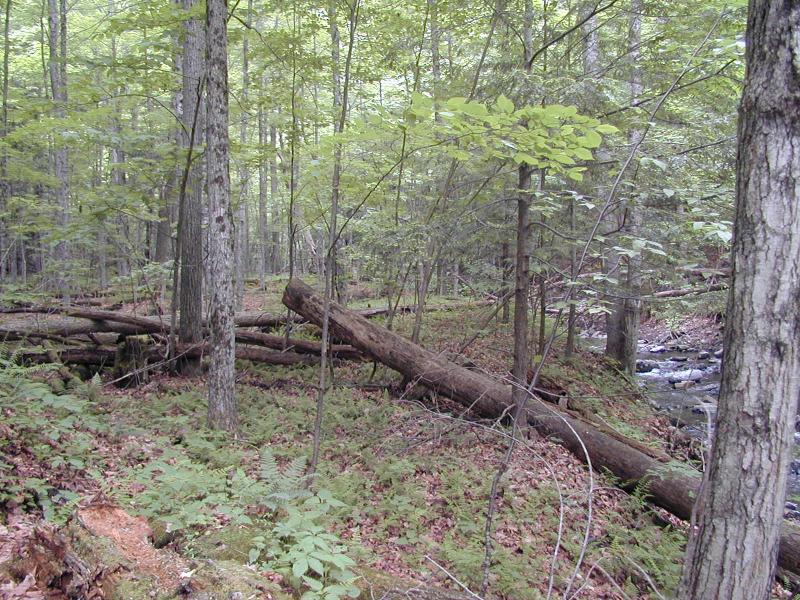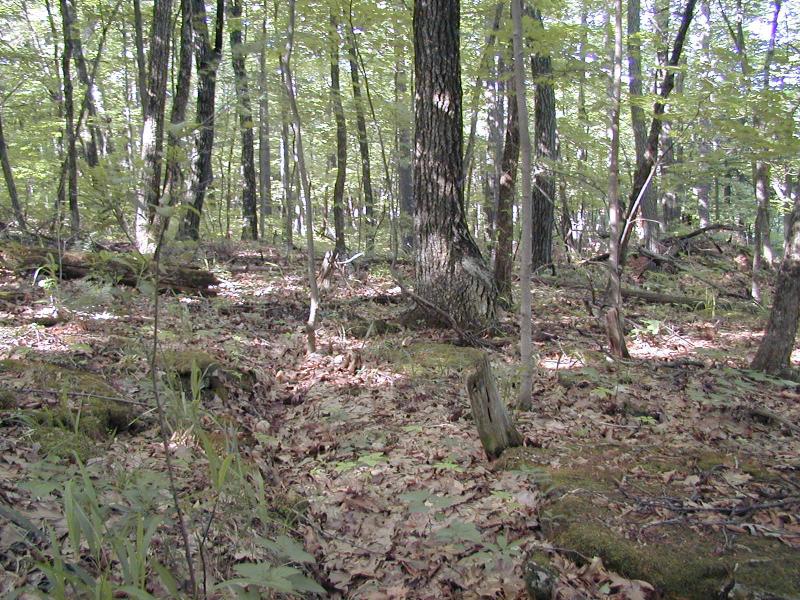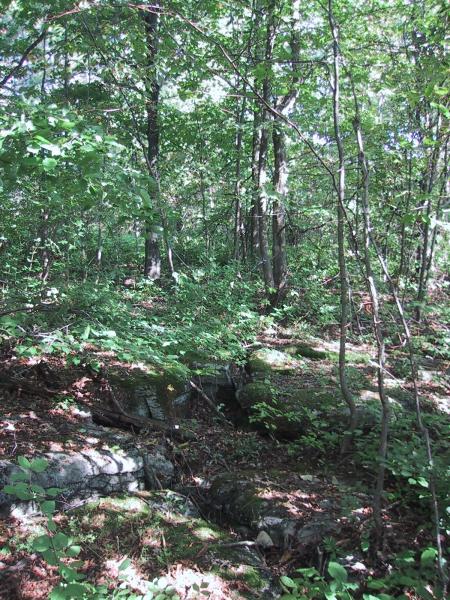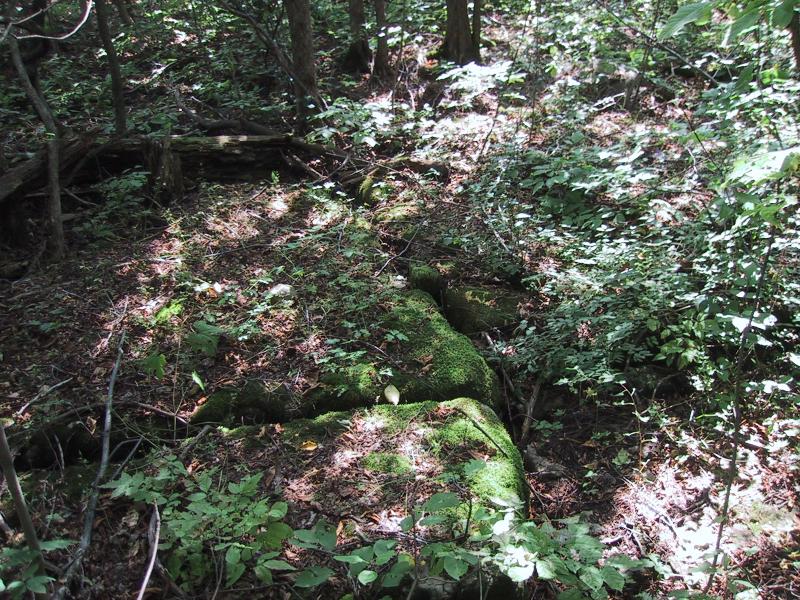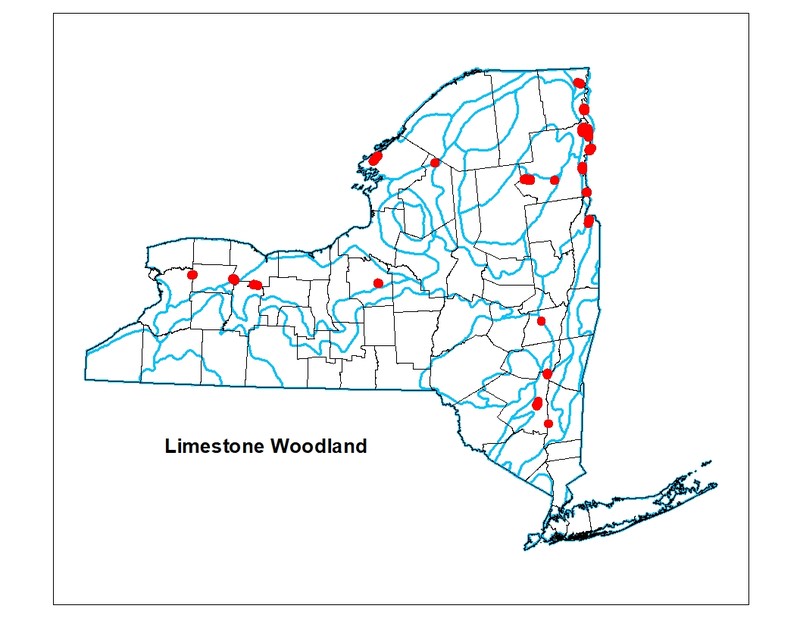Limestone Woodland
- System
- Terrestrial
- Subsystem
- Barrens And Woodlands
- State Protection
- Not Listed
Not listed or protected by New York State.
- Federal Protection
- Not Listed
- State Conservation Status Rank
- S2S3
Imperiled or Vulnerable in New York - Very vulnerable, or vulnerable, to disappearing from New York, due to rarity or other factors; typically 6 to 80 populations or locations in New York, few individuals, restricted range, few remaining acres (or miles of stream), and/or recent and widespread declines. More information is needed to assign either S2 or S3.
- Global Conservation Status Rank
- G3G4
Vulnerable globally, or Apparently Secure - At moderate risk of extinction, with relatively few populations or locations in the world, few individuals, and/or restricted range; or uncommon but not rare globally; may be rare in some parts of its range; possibly some cause for long-term concern due to declines or other factors. More information is needed to assign either G3 or G4.
Summary
Did you know?
Wild strawberry (Fragaria virginiana) and barren strawberry (Waldsteinia fragaroides) are common herbs on the forest floor of limestone woodlands. Although both spread by runners, barren strawberry, as its name suggests, does not produce a fleshy fruit. It may be found next to the fleshy-fruit-bearing wild strawberry. The Iroquois consider wild strawberries to be a symbol of a new beginning because they are one of the earliest flowers and fruits of the year. They drink strawberry juice at this time to cleanse the soul and the spirit.
State Ranking Justification
There are several hundred occurrences statewide. There are some documented occurrences that have good viability and many are protected on public land or private conservation land. This community is limited to areas underlain with limestone bedrock across the state, and includes several large, high quality examples. The current trend of this community is probably stable for occurrences on public land, or declining slightly elsewhere due to moderate threats related to development pressure and invasive plant species.
Short-term Trends
The number and acreage of limestone woodlands in New York have probably declined slightly in recent decades as a result of logging, conversion to agriculture, and other development.
Long-term Trends
The number and acreage of limestone woodlands in New York have probably declined substantially from historical numbers as a result of logging, conversion to agriculture, and other development.
Conservation and Management
Threats
Threats to limestone woodlands in general include changes in land use (e.g., clearing for development), forest fragmentation (e.g., roads), and invasive species (e.g., insects, diseases, and plants). Other threats may include over-browsing by deer, fire suppression, and air pollution (e.g., ozone and acidic deposition).
Conservation Strategies and Management Practices
Minimize or avoid habitat alteration within the woodland and surrounding landscape. Prevent recreational overuse. Remove or prevent the spread of invasive exotic species into the woodland through appropriate direct management, and by minimizing potential dispersal corridors, such as trails and roads.
Development and Mitigation Considerations
A natural (usually forested) buffer around the edges of this community will help it maintain the microclimatic characteristics that help make this community unique.
Inventory Needs
Survey for occurrences statewide to advance documentation and classification of limestone woodlands. A statewide review of limestone woodlands is desirable, perhaps using GIS modeling to locate new occurrences. Known examples in New York range from evergreen-dominated with northern white cedar (Thuja occidentalis), to mixed evergreen-deciduous, to deciduous dominated with sugar maple (Acer saccharum) and/or oak (Quercus spp.). Continue searching for large sites in good condition (A- to AB-ranked).
Research Needs
Collect sufficient plot data to support the recognition of several distinct limestone woodland types based on composition and physical characteristics. Known examples in New York range from evergreen-dominated with northern white cedar (Thuja occidentalis), to mixed evergreen-deciduous, to deciduous dominated with sugar maple (Acer saccharum) and/or oak (Quercus spp.). The current classification includes a wide range of physiognomy (e.g., woodland, forest), and moisture gradient (e.g., dry, moist, wet). These types may correspond to ecoregional distribution, or specific limestone geology.
Rare Species
- Agastache nepetoides (Yellow Giant Hyssop) (guide)
- Agrimonia rostellata (Woodland Agrimony) (guide)
- Andersonglossum boreale (Northern Wild Comfrey) (guide)
- Andersonglossum virginianum (Southern Wild Comfrey) (guide)
- Aplectrum hyemale (Puttyroot) (guide)
- Asplenium scolopendrium var. americanum (Hart's-tongue Fern) (guide)
- Asterocampa clyton (Tawny Emperor) (guide)
- Blephilia ciliata (Downy Wood Mint) (guide)
- Boechera grahamii (Graham's Rock Cress) (guide)
- Borodinia missouriensis (Green Rock Cress) (guide)
- Botrychium neolunaria (Common Moonwort) (guide)
- Bouteloua curtipendula var. curtipendula (Side Oats Grama) (guide)
- Calephelis borealis (Northern Metalmark) (guide)
- Carex aggregata (Glomerate Sedge) (guide)
- Carex backii (Back's Sedge) (guide)
- Carex careyana (Carey's Sedge) (guide)
- Carex davisii (Davis' Sedge) (guide)
- Carex formosa (Handsome Sedge) (guide)
- Carex jamesii (James' Sedge) (guide)
- Carex meadii (Mead's Sedge) (guide)
- Carex molesta (Troublesome Sedge) (guide)
- Carex richardsonii (Richardson's Sedge) (guide)
- Carex striatula (Lined Sedge) (guide)
- Chamaelirium luteum (Fairywand) (guide)
- Cirriphyllum piliferum (Hair-pointed Moss) (guide)
- Corydalis aurea (Golden Corydalis) (guide)
- Crotalus horridus (Timber Rattlesnake) (guide)
- Cypripedium arietinum (Ram's Head Lady's Slipper) (guide)
- Cypripedium candidum (Small White Lady's Slipper) (guide)
- Descurainia pinnata ssp. brachycarpa (Northern Tansy Mustard) (guide)
- Didymodon ferrugineus (Rusty Beard-moss) (guide)
- Draba arabisans (Rock Whitlow Grass) (guide)
- Draba glabella (Smooth Whitlow Grass) (guide)
- Endodeca serpentaria (Virginia Snakeroot) (guide)
- Gentianopsis virgata (Lesser Fringed Gentian) (guide)
- Halenia deflexa (Spurred Gentian) (guide)
- Hydrangea arborescens (Wild Hydrangea) (guide)
- Hydrastis canadensis (Goldenseal) (guide)
- Jeffersonia diphylla (Twinleaf) (guide)
- Linum sulcatum (Grooved Yellow Flax) (guide)
- Liparis liliifolia (Lily-leaved Twayblade) (guide)
- Myotis leibii (Eastern Small-footed Myotis) (guide)
- Myotis lucifugus (Little Brown Bat) (guide)
- Myotis septentrionalis (Northern Long-eared Bat) (guide)
- Myotis sodalis (Indiana Bat) (guide)
- Myurella julacea (Small Mousetail Moss) (guide)
- Platanthera hookeri (Hooker's Orchid) (guide)
- Platydictya jungermannioides (False Willow Moss) (guide)
- Poa sylvestris (Forest Blue Grass) (guide)
- Pseudocalliergon turgescens (Curving Feather Moss) (guide)
- Pterospora andromedea (Pine Drops) (guide)
- Pycnanthemum torreyi (Torrey's Mountain Mint) (guide)
- Solidago rigida var. rigida (Stiff Flat-topped Goldenrod) (guide)
- Tomostima reptans (Carolina Whitlow Grass) (guide)
- Triphora trianthophora (Nodding Pogonia) (guide)
- Ulmus thomasii (Rock Elm) (guide)
- Valerianella chenopodiifolia (Goosefoot Cornsalad) (guide)
Range
New York State Distribution
This community is currently known from the central Hudson Limestone Valley, the Lake Champlain Valley, the non-alvar portions of the St. Lawrence Valley, and across the Ontario Lake Plain.
Global Distribution
The range of the physically and physiognomically broadly-defined community may be worldwide. Examples with the greatest biotic affinities to New York occurrences are suspected to span north to southern Ontario, west to Minnesota and Illinois, south probably to Tennessee, southeast to Maryland, and northeast possibly to Maine.
Best Places to See
- Lake Alice Woods, Lake Alice Wildlife Management Area
- Lake Alice Wildlife Management Area (Jefferson County)
- Onondaga Escarpment Unique Area
- Great Vly Wildlife Management Area (Greene, Ulster Counties)
- Clark Reservation State Park (Onondaga County)
- John Boyd Thacher State Park
Identification Comments
General Description
Characteristic limestone woodland canopy trees in some stands are primarily conifers such as northern white cedar (Thuja occidentalis), white pine (Pinus strobus), white spruce (Picea glauca), and balsam fir (Abies balsamea). In other stands the characteristic canopy trees are primarily hardwoods such as hop hornbeam (Ostrya virginiana), sugar maple (Acer saccharum), shagbark hickory (Carya ovata), bitternut hickory (C. cordiformis), white oak (Quercus alba), bur oak (Q. macrocarpa), red oak (Q. rubra), chinkapin oak (Q. muhlenbergii), basswood (Tilia americana), and common hackberry (Celtis occidentalis). There are also stands that include mixtures of these conifers and hardwoods.
Characters Most Useful for Identification
Limestone woodlands are conifer or hardwood dominated woodlands that occur on shallow soils over limestone bedrock, and usually include numerous small rock outcrops. Typical examples have pure calcareous bedrock such as limestone, dolomite, calcite, or marble. Other examples may have hybrid bedrock types such as amphibolites or Potsdam sandstone. The tree canopy may be open or closed. There are usually several codominant trees, although one species may become dominant in any one stand.
Elevation Range
Known examples of this community have been found at elevations between 40 feet and 1,575 feet.
Best Time to See
Limestone woodlands offer a particularly nice array of spring ephemerals and early wildflowers from May to June.
Limestone Woodland Images
Classification
International Vegetation Classification Associations
This New York natural community encompasses all or part of the concept of the following International Vegetation Classification (IVC) natural community associations. These are often described at finer resolution than New York's natural communities. The IVC is developed and maintained by NatureServe.
- Sugar Maple - Hophornbeam - Shagbark Hickory - Northern Red Oak Limestone Woodland (CEGL005059)
- Sugar Maple - Chinquapin Oak / Broadleaf Sedge Forest (CEGL006162)
- Sugar Maple - Chinquapin Oak Forest (CEGL005010)
- Northern White-cedar / Balsam Fir - Mountain Maple Forest (CEGL002449)
- Northern White-cedar Limestone Bedrock Woodland (CEGL005050)
NatureServe Ecological Systems
This New York natural community falls into the following ecological system(s). Ecological systems are often described at a coarser resolution than New York's natural communities and tend to represent clusters of associations found in similar environments. The ecological systems project is developed and maintained by NatureServe.
- Laurentian-Acadian Calcareous Rocky Outcrop (CES201.572)
- Laurentian-Acadian Northern Hardwood Forest (CES201.564)
Characteristic Species
-
Trees > 5m
- Acer saccharum (sugar maple)
- Carya ovata var. ovata (shagbark hickory)
- Fraxinus americana (white ash)
- Ostrya virginiana (hop hornbeam, ironwood)
- Pinus strobus (white pine)
- Quercus alba (white oak)
- Quercus macrocarpa (bur oak)
- Quercus montana (chestnut oak)
- Quercus rubra (northern red oak)
- Thuja occidentalis (northern white cedar, arbor vitae)
- Tilia americana var. americana (American basswood)
-
Shrubs < 2m
- Vaccinium pallidum (hillside blueberry)
-
Herbs
- Avenella flexuosa (common hair grass)
- Carex pensylvanica (Pennsylvania sedge)
- Fragaria virginiana ssp. virginiana (common wild strawberry)
- Pteridium aquilinum ssp. latiusculum (eastern bracken fern)
- Solidago caesia var. caesia (blue-stemmed goldenrod, wreath goldenrod)
- Trillium grandiflorum (white trillium)
- Waldsteinia fragarioides
Similar Ecological Communities
- Alvar woodland
(guide)
Alvar woodlands occur on Chaumont limestone (Galoo-Rock outcrop complex) within a mosaic of other alvar communities. Limestone woodlands occur statewide in areas underlain by various limestone bedrock types in a non-alvar landscape.
- Calcareous pavement woodland
(guide)
Calcareous pavement woodlands are more open and have larger areas of exposed, flat bedrock than limestone woodland. Limestone woodlands have a more continuous ground layer and the rock outcrops are usually smaller and not necessarily flat .
- Calcareous talus slope woodland
(guide)
Calcareous talus slope woodlands form on talus slopes, rather than on level or slightly undulating bedrock with very little soil development. A talus slope is composed of rock fragments that are derived from, and form at the base of, a cliff or very steep rocky slope.
- Maple-basswood rich mesic forest
(guide)
Maple-basswood rich mesic forests typically have deeper soils and lack the numerous small limestone rock outcrops that are characteristic of limestone woodlands.
Vegetation
Percent cover
This figure helps visualize the structure and "look" or "feel" of a typical Limestone Woodland. Each bar represents the amount of "coverage" for all the species growing at that height. Because layers overlap (shrubs may grow under trees, for example), the shaded regions can add up to more than 100%.
Additional Resources
References
Edinger, G. J., D. J. Evans, S. Gebauer, T. G. Howard, D. M. Hunt, and A. M. Olivero (editors). 2014. Ecological Communities of New York State. Second Edition. A revised and expanded edition of Carol Reschke’s Ecological Communities of New York State. New York Natural Heritage Program, New York State Department of Environmental Conservation, Albany, NY. https://www.nynhp.org/ecological-communities/
Edinger, Gregory J., D.J. Evans, Shane Gebauer, Timothy G. Howard, David M. Hunt, and Adele M. Olivero (editors). 2002. Ecological Communities of New York State. Second Edition. A revised and expanded edition of Carol Reschke's Ecological Communities of New York State. (Draft for review). New York Natural Heritage Program, New York State Department of Environmental Conservation. Albany, NY. 136 pp.
New York Natural Heritage Program. 2024. New York Natural Heritage Program Databases. Albany, NY.
Reschke, Carol and B. Gilman. 1988. Vegetation of the limestone pavements in Jefferson County, New York. Poster presented at the 15th Annual Natural Areas Conference, Syracuse, New York.
Reschke, Carol. 1990. Ecological communities of New York State. New York Natural Heritage Program, New York State Department of Environmental Conservation. Latham, NY. 96 pp. plus xi.
Sorenson, E. and R. Popp. Limestone bluff cedar-pine forests of Vermont: A statewide inventory. Nongame and Natural Heritage Program, Vermont Fish and Wildlife Department, Agency of Natural Resources, Waterbury, Vermont.
Links
About This Guide
This guide was authored by: D.J. Evans
Information for this guide was last updated on: February 5, 2024
Please cite this page as:
New York Natural Heritage Program. 2024.
Online Conservation Guide for
Limestone woodland.
Available from: https://guides.nynhp.org/limestone-woodland/.
Accessed July 27, 2024.
